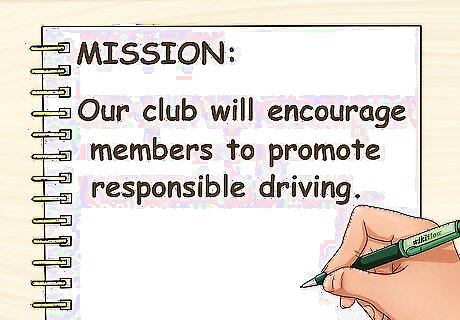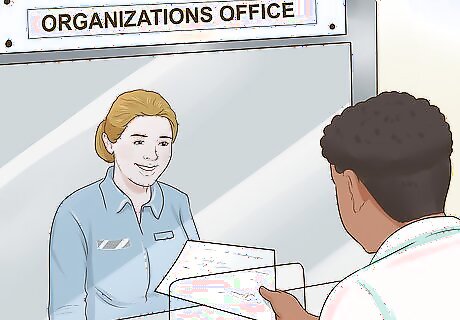
views
Club Development

Determine a focus for the club. Car clubs can either focus on one car brand or model, or they can be all-inclusive for anyone who is passionate about cars. It is good to decide what you want the focus to be so that you and the people who join can get the most out of the club. Whether you focus on one type of car or keep it open will have some bearing on the goal and mission of the club. A club focused on one car might mean your members have more in common, but an open group will most likely draw more people to want to join. You might start the club with one intention in mind, but as the club progresses you may decide that you want to shift the focus in a new direction. This is perfectly fine if it serves your members well.

Write a mission statement. Your club will only grow and be successful if you have an idea of what the purpose is. It is good to write down something specific which briefly outlines what your club is about. For example, you might say, “Our club will encourage members to perform preventive maintenance, help members build friendships, and promote responsible driving.” You may want to make new members officially accept the mission statement in some way, perhaps by signing a membership agreement. You can write up a draft of this mission statement on your own, but you can also ask others for input as new people join the club.

Make long-term goals for the club. Goals could range from reaching a certain number of members to growing into a non-profit or business. Set goals that are specific and that you can easily tell once they have been accomplished. You might even have individual members set personal goals for what they hope to get out of the club. Other examples of goals are host five car-themed charity events in the next year, have all members gain car maintenance or detailing certifications, and make a cross country road trip during the summer.
Club Establishment

Secure a meeting place. Since the club revolves around your cars, it’s usually good to find somewhere that has a large parking lot. You may even want to hold the meeting in the parking lot so you can be around your cars. On occasion, you may want to hold the meeting in a large garage so you can be with the cars and be inside. The location of your meeting will be partly determined by where you live and what is available to you. Community centers and churches often rent their space out to groups, so those are good options to check out. If you can arrange to rent a space on a regular basis, this will make it easier for people to always know where the meeting is going to be. It’s likely that you will need to pay to rent a space, so it’s important to figure out where this money will come from. You may have to cover it yourself the first time, and then you can collect dues or rent money from the members of your club.

Gather people to attend the first meeting. Ask any close friends or acquaintances who are car enthusiasts if they would come to your first meeting and if they would be interested in becoming members of a car club. You can tell them the place and time and give them an idea of what some of the meeting’s content will be. You can spread the word to lots of people if you want, but for a first meeting it might be better to just have a handful of interested people. You can expand from there. Tell the people you gather that they can invite anyone else they know that loves cars. You might build a large club just by asking people that someone already knows as opposed to inviting strangers.

Hold the meeting. Welcome all the new members and potential members. Talk about the mission of the club, any restrictions and requirements, and what members can expect from the car club. Share information about any dues that will be collected, and how the club will be structured. Talk about leadership, and what will be expected from the people who manage the club. You may want to print out copies of the agenda so people have an idea of what all you want to cover in the first meeting. Start out by having everyone introduce themselves and mention something they like about cars. At least for the first meeting, it’s great to have some food as a draw and a centerpiece for initial hanging out and conversing.

Make follow up phone calls. After the first meeting, call the people who attended to get their feedback and thoughts about further involvement with the club. You don’t want to set a date for the next meeting and find out that no one is interested in doing anything else. Tell people at the meeting that you’ll be reaching out to them. You could also have people fill out a feedback card of some kind to give you an idea about where everyone stands in regards to the club. During the phone call, ask people how they felt the meeting went, whether or not they would like to participate in the club, and what they would like to see the club do in the future.
Club Expansion

Build an online presence. Most organizations, businesses, and groups in the modern era thrive because of their online presence. You can go the simple route of starting up a Facebook page for your club, or you can create a website. If you aren’t good with social media, enlist the help of one of your early joiners to create the online club page. This can have contact information for the club’s leader, meeting location and other details, the clubs purposes and mission statement, and other relevant information that someone searching for the club would want to know. As the club grows, this can become a vital resource for staying connected as a group. It can be a place to message members, post cool articles and videos, and alert your members to any upcoming events or changes to schedules.

Print business cards and flyers. While an online presence is important, getting your name out there still requires more than just a website. You can post flyers around your college campus, high school, office, church, or anywhere else around town. Cards can be carried by the founding members to pass out to people. Business cards and flyers should have the name of your club, some contact info, and a brief blurb about the purpose of the club. Local mechanic shops would be a great place to leave some flyers and cards. Flyers are great because they are a constant presence that will ideally stay where you put them for quite a while. They’ll get more views than handing a business card to one person. You can go through parking lots and place these on cars that seem like they belong to people who would be interested in an enthusiasts club. Some of your meetings might focus on just reaching out to new people and handing out flyers and cards.

Host call out meetings on occasion. Once your club has been established for a little while, perhaps a few months, you can hold meetings that are specifically designed to invite new people. This could be sort of like a mixer which has a welcoming environment to make potential members feel comfortable. If you feel that your club is at a good size, you may not want to continue expanding. It’s okay to find a size that works well and allow the group to hang out there for a while.

Make it official. If your club is based around a university, talk to the clubs or organizations office and get an official sanction. The benefit of this is that you can get university funding for your programs and events. Another option is to seek out accreditation from a national car club. You can become a charter club that is part of their official network. There are many benefits to belonging to a larger organization, and national car club chapters can usually advise the local chapters on management, event planning and marketing opportunities. Check out a registry like http://www.jctaylor.com/car-club-directory/ to browse national car clubs.



















Comments
0 comment